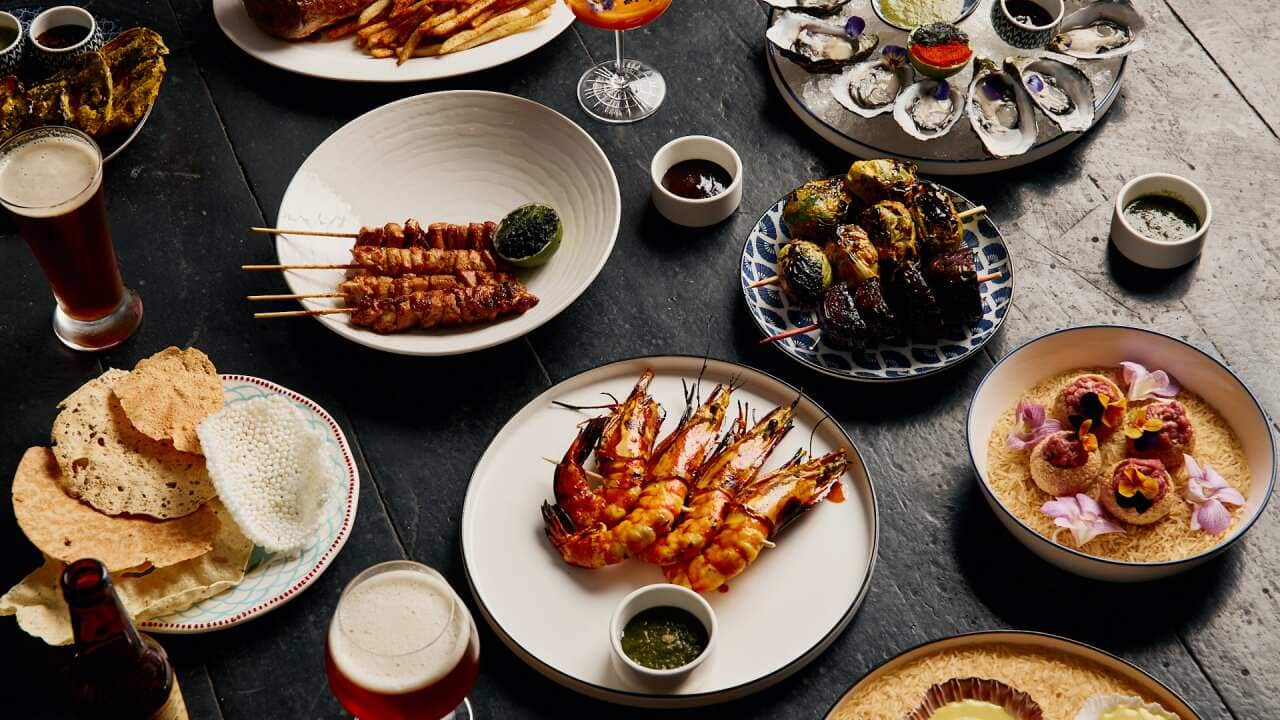Every part of India has its own version of a thali meal, depending on what food it grows. Although it can be broadly classified as South-Indian and North-Indian.
The word "thali" means plate and is an old custom which began in South and Southeast Asia. It's essentially a traditional meal that's served with up to 10 varieties of dishes in small round bowls called katoris. They are arranged on a big plate known as a thali.
On special celebrations, including wedding feasts and festivals like Diwali, thali meals include more dishes and they're served on a plantain leaf and sometimes a silver platter, depending on your family's tradition.
I was born and raised in Chennai, Southern India, where traditional thalis include grains, lentils, seasonal vegetables, a condiment called , pickles and a . Before my school years, my daily lunches consisted of a four-to-five dish vegetarian thali made by my grandmother Ponnammal. After that, my mother Chandra would only cook elaborate thali on weekends and special occasions.
Before my school years, my daily lunches consisted of a four-to-five dish vegetarian thali made by my grandmother Ponnammal. After that, my mother Chandra would only cook elaborate thali on weekends and special occasions.

India's thali meals cary depending on the region. Source: Deepa Mani
Mum's thalis were much more involved than the traditional thalis my grandmother made. Mum made all the fancy dishes. They would include stews made with lentils known as sambar, a soup called rasam that uses a tamarind-juice base, tomato, and is seasoned with chilli pepper, cumin and other spices. She also made homemade raita, which is essentially plain yoghurt usually mixed with a vegetable, vegetable curry, bowls of fried veggies (mainly okra), potato fry or deep-fried lentil wafers known as appalam, and .
They were accompanied by flavoured rice, which could be lemon, coconut, tamarind, capsicum or fried rice. We would have a sweet to finish. When I got married in 2008, we had 4,000 guests for which we catered a massive thali served on plantain leaves.
When I got married in 2008, we had 4,000 guests for which we catered a massive thali served on plantain leaves.

Deepa Mani with her mum and grandmothers. Source: Supplied
The day began by serving our guests breakfast. Choices included an Indian risotto known as , a variety of sambar and chutney dishes such as coconut and , a deep-fried bread called poori, , , and sweets.
Lunch and dinner featured a thali buffet where guests could pick from at least 20 different varieties.
HOW TO MAKE IDLI AND DOSA

You need to eat idli
The thali meal tradition to Melbourne
A few months after my wedding, I moved to Melbourne, Australia, to join my partner who is also of Indian heritage. Thali came with me.
As a child, I grew up observing my mum and grandmother's thali cooking techniques, but it was only once I was married that I attempted to make thali as I wanted to share it with my extended family.
Because I grew up tasting thali daily, it has become part of my genes.
Because I grew up tasting thali daily, it has become part of my genes. Knowing the smells, textures and flavours like the back of my hand helped me to make my first thali, although I did call mum for the exact recipes.
The recent lockdown in Melbourne gave me a lot of time to practise so I can now whip up five thali dishes up for my family within an hour. The most time-consuming parts involve tempering the leaves and spices in ghee, and making curry pastes. But once that's done, it's a matter of loading your pressure cooker with layers of vegetables for each dish and cooking the rice in the rice cooker. For everything else, the secret is to have each pot cooking simultaneously on the stove. Your lentils might be in one pot, and a soup broth or a curry paste might simmer on another, for example. Then you can divide the veggies and sauté them with their corresponding sauces.
For everything else, the secret is to have each pot cooking simultaneously on the stove. Your lentils might be in one pot, and a soup broth or a curry paste might simmer on another, for example. Then you can divide the veggies and sauté them with their corresponding sauces.

A lot of effort goes into making thali meals, but the more you practice, the easier it gets. Source: Peter Tarasiuk
After that, add shredded coconut, fresh chillies and seeds, depending on what your side dishes need. The sauteed vegetable dish poriyal, for example, has shredded coconut at the end to garnish, and the kootu lentil and vegetable stew needs a gravy consistency, which requires paste to be ground and mixed with the boiled vegetables and then garnished with the tempered spices.
Once you get to know the recipes and repeat them a few times it becomes easier.
A NEW TAKE ON THALI

Jessi Singh opens his most 'unauthentic Indian' restaurant yet
The health benefits of thali meals
Thalis contain plant-based protein, fibre, minerals, vitamins, good fats and carbs. A spoonful of ghee, a class of clarified butter, can also and aid digestion.
A thali meal also contains all six tastes: sour, salty, astringent, bitter, sweet and spicy, which according to Ayurvedic food science play a vital role in our physiology, health and wellbeing.
Having a simple thali for lunch helps keep my family healthy as it gives us four serves of veggies per day, keeps our blood glucose levels steady and is full of great flavour.
MORE INDIAN FOOD

Reconnecting with Indian food helped me improve my IBS







